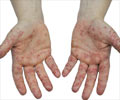April is observed as the Sexually Transmitted Disease (STD) Awareness Month in the States. Syphilis is back!
- The Sexually Transmitted Disease (STD) Awareness Month is observed annually in the U.S. in April.
- STDs continue to be a raging menace in America, as well as the rest of the world.
- The 2017 STD Awareness Month theme is ‘Syphilis Strikes Back’.
Let us take a look now into the 2017 STD Awareness Month theme-‘Syphilis Strikes Back’.
How much do we, the common man, know about syphilis? Very little, unfortunately, since the disease was known to have been largely wiped out since World War II, following the discovery of penicillin. However, our time to rejoice might end soon, since syphilis is back - with a bang!
Syphilis occurs in four stages - primary, secondary, latent and tertiary. Each stage shows different symptoms of the disease. A primary syphilis patient usually has sores in the genital area, in the anus or rectum, and around the mouth. Secondary syphilis can manifest itself in skin rashes, swollen lymph nodes and even fever. But these signs are mild and can go unnoticed for the most part. Untreated syphilis then progresses to the latent stage where there are no significant symptoms. Yet the infection can continue to grow in the body. The final stage, tertiary syphilis on the other hand, can take severe forms, affecting the eyes, brain, heart, as well as other organs of the body. This stage can show up several years after the infection first entered the body.
The 2015 U.S surveillance data revealed a staggering 19% increase in the number of reported cases since 2014, and the highest annual number of reported cases of syphilis in over 20 years. From a matter of negligible concern, the disease has suddenly become a major public health issue, in the States, and around the world.
Syphilis, however, is treatable.
The Centers for Disease Control and Prevention (CDC), Atlanta, Georgia, undertakes the month long awareness and prevention programs for STDs in April, making the best they can of this yearly opportunity to reach out to millions of STD infected people across the States. Worse still, a very high percentage of people do not know that they are infected in the first place!
STDs, when left untreated, are liable to causing permanent damage such as infertility, and even death. And of course, if you are infected, and do not know it, you are a risk not only to yourself, but to every single person who ends up being your sexual partner at some point of time.
In 2017, each week in April will be dedicated to a particular aspect of the syphilis onslaught.
- Syphilis in the U.S (April 1-8): The first week of the month focuses on general awareness, in efforts to acquaint the public with the fundamentals of the disease and to raise the alarm regarding this potentially life-threatening disease.
- Syphilis among gay, bisexual and other MSM (Men having Sex with Men)(April 9-15): The second week will focus entirely on the sections of the population that are worst hit by the disease. Extensive awareness campaigns will also be undertaken to create leadership in healthcare for the affected population.
- Syphilis among women, pregnant women, and newborns (April 16-22): This week will concentrate on the growing incidences among women. Since syphilis is transmittable from mother to child, it is essential for sexually active women to get themselves tested, and treated, in case they are diagnosed positively.
- Disrupt Syphilis! (April 23-30): The final week will bring up the rear with treatment and prevention strategies, aiming to chalk out a path to address the menace of syphilis in the coming days.
- Engaging in sexual activity at an early age: Starting out early increases the risk of infection. The younger you start the more likely you are to be reckless, to have unprotected sex, and a larger number of sexual partners.
- Multiple sex partners: More number of people you choose to have sexual encounters with, even though it may not involve intercourse, the greater your risk of infection. Individuals who lead a largely monogamous life are therefore at significantly lesser risk of contracting the disease.
- Unprotected sex: Indulging in unprotected sex increases your chances of getting infected by leaps and bounds. Protect yourself every time you have intercourse.
Chlamydia: Chlamydia is the most commonly notifiable disease in the U.S. with the highest incidence recorded among all STDs. Young women are generally worst hit.
Gonorrhea: This is the second most commonly reported STD in the U.S. Studies have revealed that gonococcal infections can be complicit in HIV transmission.
Human Papillomavirus: 90% of HPV infections exhibit no significant symptoms. In women, HPV accounts for about 70% of reported cervical cancer incidences in America.
Herpes Simplex Virus (HSV):
HSV Type 1 and Type 2 often go undiagnosed. However, the heightened rate of clinical visits for HSV infection over the years is a possible indicator of increased diagnosis. It should be noted that syphilis, gonorrhea, and HSV patients are at higher risk of contracting HIV which in turn can progress to AIDS. Life expectancy of untreated AIDS patients is usually 1-3 years.The Indian Scene
India’s STD scenario is steadily assuming mammoth proportions. It registers the 3rd highest rates of HIV incidences in the world; currently the country spends about 5% of its health budget on HIV/AIDS treatment.
In different parts of India, chancroid, gonorrhea, herpes and syphilis incidences are alarmingly high, with the highest incidences recorded among the Indian youth. Most heart-rending about the Indian situation is the rise of STD rates among children, which indicates a devastating incidence of child trafficking, child sexual abuse and complete lack of sex education in the country.
The myth that intercourse with a virgin cures STD is still rampant in the Indian society, thereby aiding in the continued practice of abusing young girls to cure oneself. Lack of screening and diagnosis of sex workers, and stigmatization of STD patients are also responsible for STD spread.
Untreated STDs can prove fatal, yet they have the most significant effects on women, who run the risk of infecting their babies for life. Thus, if you are diagnosed, seek help. Remember there is no shame in getting treatment, and perhaps saving more than one life!
References:
- STD Awareness Month - (https://www.cdc.gov/std/sam/index.htm)
- Chlamydia - (https://www.cdc.gov/std/stats15/chlamydia.htm)
Source-Medindia
















